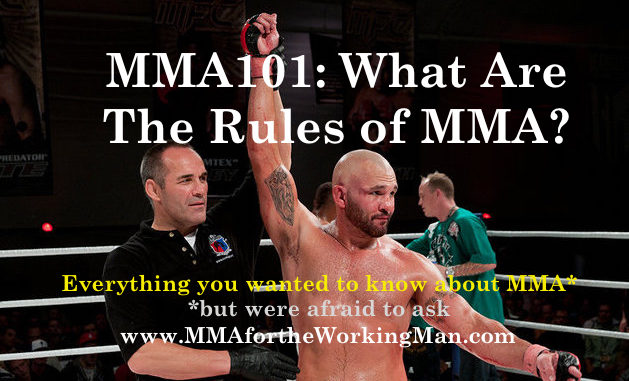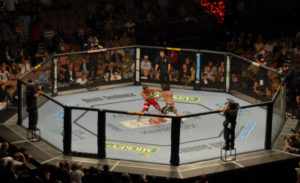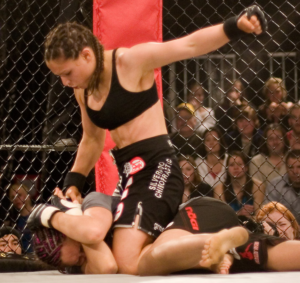
MMA 101: What are the rules of MMA?
Part of a series: Everything you always wanted to know about MMA*
*but were afraid to ask
You and your girlfriend, and perhaps a couple of buddies, are watching UFC on Pay Per View. The fights are brutal – reminiscent of the cult-classic movie Fight Club, or an underground cage fight to the death run by the mob. This impression of violence is further enforced whenever a well-placed elbow or knee strike splits open a head, spattering the canvass with blood. Your girlfriend shakes her head “OMG! Does this sport have any rules?”
While this topic might be a familiar one to veteran fans and fighter, to a newbie it can be embarrassing to ask. So let’s tackle this question: “What are the rules of MMA?”
I’ll try my best to cover this question with a Long Answer first, and I’ll summarize everything with a Conclusion/Short Answer in the end.
Long Answer:
While to the uninitiated MMA looks like a no-holds-barred blood bath, there are quite a number of rules that make MMA a safe sport. MMA is rightfully hyped as “the world’s fastest growing sport” as more and more countries and fans embrace the sport. However, despite its current worldwide appeal, MMA is still relatively a very young as an organized sport. Compared to grandpa’s boxing, or old uncle Guss’s wrasslin’ MMA is a mere baby. There is no formally recognized global umbrella organization which regulates the sport. While there are de facto industry leaders, it’s typically up to the individual promotions and each country’s government regulatory bodies to thresh out what the rules really are.
When it comes to the topic of MMA rules, the UFC, played a special role.
What is the role of the UFC in creating MMA rules?

The UFC or Ultimate Fighting Championship’s rise to prominence is closely associated with the formation of MMA itself as a sport. Since catapulting to worldwide fame in the 1990’s, the UFC has remained the world’s gold standard in MMA. And, it seems that the UFC will maintain this much deserved status for many years to come, despite there being hundreds of smaller MMA promotions around the world today.
It’s no surprise then that many major MMA promotions adopt the same rules the UFC uses, the Unified Rules of Mixed Martial Arts established by the New Jersey Athletic Control Board. Other MMA promotions also adopt these rules either because they are either required to by government athletic regulatory bodies of the jurisdictions they belong to, or by choice to bring their own promotions into the scope of what is internationally accepted. These Unified Rules have been adopted by other all other relevant regulatory athletic state commissions in the US, and become the de facto set of rules for professional Mixed Martial Arts by many promotions around the world.
How did these rules come about?
As a teenager, I’ve watched the early UFC events since UFC 1 in 1993 countless times. The progression of the rules from bloody spectacle to modern sport was very palpable in the early days. The earliest UFC events had only two rules, (yes two, that’s not a typo), 1. No Biting, 2. No eyes gouging. (Note: groin strikes were banned in UFC 1 but were allowed in next couple of events). From a historical perspective, the use of these two rules is interesting because Ancient Greek Pankration also only had these two rules. Overtime, more and more rules were added to the UFC. The absence of rules in UFC present in more mainstream martial arts made some very cringe-worthy, but highly-entertaining spectacles. My favorite one was an incident in UFC 4 in December 1994 where Joe Son, founder of the martial arts style “Jo Son Do,” was brutally pounded multiple times in the groin while held down to the canvass by an “Eagle Claw” to the throat by Kenpo Karate black belt Keith Hackney.
As the UFC organized more events during the 90’s, rules such as time limits, of use of protective gloves and other main features of MMA’s rules were added. Many of these rules were purposely added to steer the sport away from the image of a no-holds-barred fight or “human cockfighting” as some detractors called MMA at the time.
As the sport continued to soar in popularity, so did the need to create a standardized set of rules. In April 3, 2001 the New Jersey State Athletic Control Board (NJSACB) the uniform rules were agreed upon by the NJSACB and several other several other regulatory bodies, as well as numerous MMA promoters. These rules were quickly adopted all over the United States.
Today’s Unified Rules on the UFC website list more than 30 fouls. A list of these fouls is also at the bottom of this article for convenience.
How about the sport Vale Tudo?

Before leaving the topic of the UFC as a trendsetter for the formation of MMA and its rules, I would be an injustice not to mention the Brazilian sport Vale Tudo, a sport widely recognized as the precursor of MMA that had its roots as far back as the 1920’s. Vale Tudo is a Portuguese word which literally meaning “anything goes”. As the name suggests, this sport generally has very minimal rules and features fights with bareknuckled fighters, no weight classes, time limits – very similar to the earliest UFC events. It bears noting that the UFC was founded with the help of the famous Gracie family, Brazilian Jiujitsu practitioners who were some of the most important movers behind the sport of Vale Tudo in Brazil.
What are the ways one can win in an MMA fight?
Technically, there are several ways to win an MMA fight, but if you get down to the most bare-bones basic level, you can win an MMA in three ways Submission, Knock-Out or Decision.
Submission is when your opponents signifies he can no longer continue, usually by repeatedly tapping your opponent’s body in an obvious manner to signify surrender. This usually happens when the winner has caught his opponent in a submission hold, typically a choke, arm lock or leg lock, and caught person is unable to escape and must surrender unless he his rendered unconscious by the choke or receives serious injury (e.g. broken arm, torn knee ligaments) such as in the case of an arm lock or a leg lock. Because of this tapping motion, a submission is usually referred to a Tap-Out, with the person who surrenders being described as having “tapped-out.”
You might be interested in what happens when a contestant wants to surrender, but can’t tap. For example his arms are both immobilized in a submission hold. I’ll cover that in future articles, but you can subscribe to the MFTWM (MMA for the Working Man) newsletter so you can be notified when I publish it.
A Knock-Out is when a contestant knocked unconscious due strikes or kicks (KO), when an injury as a result of a legal maneuver is sever enough to terminate a bout (TKO), or when the referee stops the contest (TKO). I’ll also discuss this in a future article which I’ll notify you of if you subscribe to our newsletter.
If no one surrenders or is knocked out by the time fight is over, the fights goes to the judges score cards and the outcome is called a Decision.
How long does an MMA fight last?
Under the Unified Rules bouts lasts for 3 five-minute rounds with one minute rests in between. For championship bouts there should be 5 five-minute rounds instead of 3, also with one minute rests in between.
Matches can end with other outcomes such as Disqualification, Forfeit, No contest, Draws, and Technical Decision. But for the vast majority of fights they end in Submissions, Knock-Outs and Decisions. For the most part, it is enough to be familiar with the difference between these three fight results.
Other MMA promotion might have different rules and numbers of rounds, such as 2 ten-minute rounds, or 3-five minute rounds. While there are no hard and fast rules, MMA promotions which do not follow the Unifies Rules still usually stick to three, five or ten minute rounds.
Aside from rules used by the UFC, the Unifies MMA Rules, what are the other rule sets?
Though the Unified MMA rules are used my most MMA major promotions, notably: Bellator MMA, World Series of Fighting (WSOF), and the all-female Invicta FC.
As mentioned, not all MMA promotions use the Unified MMA Rules Set. The most prominent MMA promotion in Asia, Singapore-based ONE Championship, uses what it calls the “Global MMA Rule Set” a set of rules which it formulated supposedly “a combination of best practices from Asian and Non-Asian Rules.” It has almost the same rules and regulations but with a major difference: it allows kicking the head of a grounded opponent while the Unified Rules of MMA does not.
Also, ONE Championship prides itself in its claimed “revolutionary weigh-in program,” which basically bans weight-cutting by dehydration and allowing only “walking-weight” competition for its athletes. This policy protects the health of fighters, keeping them from the dangerous and at-times fatal effects of drastic weight cut methods which unfortunately is the norm for many combat athletes.
You might also want to be aware that there is an amateur set of Pankration rules, which they see as a form of MMA, being promoted by the United World Wrestling (UWW, formerly known as FILA – French: Fédération Internationale des Luttes Associées, literally ‘International Federation of Associated Wrestling Styles’), the same body that regulates wrestling in the Olympics. These rules however are not catching on as fast as some people would like.
Heck, there are even some promotions where teams of five versus five fighters battle it out at the same time (no kidding!)

Aside from fouls and ways to win, what are other rules of MMA?
There are other regulations and prohibitions for both for uniformity and safety’s sake. These include rules in the area of: weight classes, duration of matches, minutes per round, official uniform, gloves, hand wrapping, ring specifications, medical requirements, refereeing, judging and other areas. With all these stringent regulations, MMA has truly evolved into a modern sport. The appeal of the sport is that despite all these rules MMA maintains many elements of actual unarmed combat, even though it had become far removed from the random, largely unpredictable and potentially fatal violence like that of a street fight or criminal attack.
MMA is the fastest growing sport and you also have to be aware that modifications to rules, even within the Unified Rules still happen as regulators and promoters continue to look out for the future of the sport, and more importantly, the safety of the fighters.
Conclusion / Short Answer:
What are the rules of MMA?
MMA has a number of set of rules, the most popular of which is the Unified MMA Rules which is used by most prominent MMA organization UFC, and most major MMA promotions world wide. There are other notable set of rules such as the “Global MMA Rule” used by Asia’s top MMA promotion, ONE Fighting Championship.
MMA allows striking and grappling techniques. An MMA fight can be won by submission (tap-out or making your opponent surrender), knock-out, or by judge’s decision. There are many other regulations aside from fouls (e.g. no eye gouging, no biting) that are there to protect a fighter’s safety, which regulate many other aspects of the game such as weight classes, cage specifications, medical requirements etc… These rules help standardize the sport and keep the fighters safe.
ANNEX: Fouls under the Unified MMA Rules
• Butting with the head
• Eye gouging of any kind
• Biting
• Spitting at an opponent
• Hair pulling
• Fish hooking
• Groin attacks of any kind
• Putting a finger into any orifice or any cut or laceration of an opponent
• Small joint manipulation
• Striking downward using the point of the elbow
• Striking to the spine or the back of the head
• Kicking to the kidney with a heel
• Throat strikes of any kind, including, without limitation, grabbing the trachea
• Clawing, pinching or twisting the flesh
• Grabbing the clavicle
• Kicking the head of a grounded opponent
• Kneeing the head of a grounded opponent
• Stomping a grounded opponent
• Holding the fence
• Holding the shorts or gloves of an opponent
• Using abusive language in fenced ring/fighting area
• Engaging in any unsportsmanlike conduct that causes injury to an opponent
• Attacking an opponent on or during the break
• Attacking an opponent who is under the care of the referee
• Attacking an opponent after the bell has sounded the end of the round
• Timidity, including, without limitation, avoiding contact with an opponent, intentionally or consistently dropping the mouthpiece or faking an injury
• Throwing opponent out of ring/fighting area
• Flagrantly disregarding the instructions of the referee
• Spiking an opponent to the canvas on his head or neck
• Interference by the corner
• Applying any foreign substance to the hair or body to gain an advantage
Other suggested readings:
Our website:
What is the difference between Grappling, Wrestling and Jiujitsu?
I once dreamt of being an MMA Champion
How I changed the way I train?
5 things I changed in the way I train in MMA and grappling by the time I hit my thirties
Other websites:
Wikipedia Article of MMA Rules
Books:
Photo credits: Rules of MMA/Brian Champ (modified), UFC cage/Lee Brimelow, Vale Tudo/Valdemar Mendes, Women’s MMA/Matthew Walsh

Leave a Reply